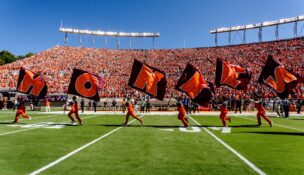Mind the gap
Va. needs 40,000 maritime, offshore wind workers by 2030

Newport News Shipbuilding employee Margaret Abrams trained at the Navy’s Advanced Training in Defense Manufacturing program, a fast-track course to help train some of the 140,000-plus trade workers needed nationally to support military shipbuilding over the next decade. Photo courtesy Huntington Ingalls Industries/Ashley Cowan

Newport News Shipbuilding employee Margaret Abrams trained at the Navy’s Advanced Training in Defense Manufacturing program, a fast-track course to help train some of the 140,000-plus trade workers needed nationally to support military shipbuilding over the next decade. Photo courtesy Huntington Ingalls Industries/Ashley Cowan
Mind the gap
Va. needs 40,000 maritime, offshore wind workers by 2030
Margaret Abrams was studying engineering at Liberty University when she came across an online job advertisement from Newport News-based Huntington Ingalls Industries.
HII, Virginia’s largest industrial employer, was offering a $2,500 signing bonus to job candidates who successfully completed a 16-week computer numerical control training at the Navy’s Advanced Training in Defense Manufacturing pilot program, managed by the Institute for Advanced Learning and Research in Danville.
After three semesters at Liberty, Abrams wasn’t satisfied with school and was eager to get to work. Working with her hands was appealing to her, and she knew she wanted a career, not just a job.
Now, Abrams, 21, has found that. After graduating in June from the ATDM program, she immediately went to work for HII’s Newport News Shipbuilding division.
“We are directly working on parts for a ship,” she says. “You can look out in the dry docks and go, ‘Oh, that’s what I’m working on,’ kind of having that constant reminder.”
Abrams, who hails from Portsmouth, is one of more than 800 people who have graduated from ATDM since the program, a public-private partnership between IALR, Danville Community College, the Navy, the Department of Defense and industry stakeholders, began in 2021.
About 170 of those graduates have stayed in Virginia, according to Jason Wells, IALR’s executive vice president for manufacturing advancement.
“We continue each year to scale-up and to ramp up, and it’s been a tremendous lift,” Wells says.
That scale-up is coming at a crucial time in Virginia. Employees like Abrams are helping fill huge gaps in maritime manufacturing jobs, which includes Navy shipbuilding and repair as well as the state’s nascent offshore wind industry.
Hampton Roads Workforce Council President and CEO Shawn Avery projects 40,000 skilled workers will be needed regionally during the next six years to support the needs of the maritime and offshore wind industries, the skills for which, including welding, CNC machining and pipefitting, overlap by about 90%. The council is helping to lead recruitment and training efforts to meet the pressing regional workforce needs.
“We’ve got to put a really big, concerted effort on filling those jobs and developing that pipeline,” Avery says.
And work is already underway to meet that demand.
Fixing a hole
The Navy says more than 100,000 skilled workers are needed in the next decade to build the nation’s newest attack and ballistic submarines, including Virginia- and Columbia-class boats. Newport News Shipbuilding, which has a construction sharing agreement with General Dynamics’ Connecticut-based Electric Boat subsidiary, is tasked with building two Virginia-class boats annually and making six modular components for each Columbia-class submarine.
That 100,000-worker tally counts the service’s submarine industrial base, which includes 15,000 suppliers. The Navy says an estimated 40,000 more workers will be needed at the Navy’s four public shipyards to sustain those submarines. Those figures do not include the workers who will be needed to build other ships, including the aircraft carriers USS John F. Kennedy and USS Enterprise at Newport News Shipbuilding, or overhaul other vessels across its fleet.
Meanwhile, Dominion Energy’s $9.8 billion, 2.6-megawatt Coastal Virginia Offshore Wind project began taking shape in May with the installation of foundations on the ocean floor to support 78 of the offshore wind farm’s 176 electricity-generating turbines, says John Larson, the Fortune 500 utility’s director of public policy and economic development.
A September 2020 report prepared by the Hampton Roads Alliance projected that the CVOW project would require 900 direct and indirect jobs during construction through 2026 and 1,100 indirect and direct jobs annually thereafter. More recently, in mid-August, a Dominion subsidiary won rights to lease more than 176,000 acres adjacent to the CVOW project, which could add up to 4 gigawatts of offshore wind power.
At least 14 companies affiliated with the offshore wind industry, including suppliers, have either moved to or expanded in the region, Larson says. One of those companies, LS GreenLink USA, announced in July that it would build a $681 million, 750,000-square-foot manufacturing plant in Chesapeake to produce high-voltage, direct-current subsea cables for offshore wind farms like CVOW. The project is expected to create more than 330 jobs.
Investments like Dominion’s and LS GreenLink’s show that the region’s efforts to promote itself as an offshore wind hub are coming to fruition, and supporting that growth will be critical, says Matt Smith, director of energy and emerging technology for the Hampton Roads Alliance, a regional economic development organization. “Ultimately,” Smith says, “we want to have kind of an ecosystem here that can … support the [offshore wind] industry on the East Coast.”
In November 2023, the workforce council received a $14 million U.S. Department of Defense grant to boost regional workforce training for the defense industrial base. That’s on top of a $11 million grant in 2022 from the U.S. Economic Development Administration to develop a maritime talent pipeline, known as the Regional Maritime Training System, or RMTS.
Reaching a 100-mile radius around Hampton Roads, the RMTS initiative includes partnerships with 30 schools, colleges and training programs to train future maritime workers in a variety of necessary skills, and it currently works directly with 18 companies that collectively make up 80% of the region’s jobs in ship-building and repair. Those numbers will continue to grow as RMTS adds partners, Avery says.
As of August, more than 1,000 people have enrolled in maritime training programs through RMTS. At least 458 RMTS graduates are now employed in maritime jobs with an average wage of $22.15 an hour, according to the workforce council.
But there’s still work to be done. According to council data, the demand for crucial industry roles, like welders, electricians, and pipefitters, to name a few, currently outstrips area supply. As an example, the region has the capacity to train 1,067 pipefitters in 2025, but with an estimated regional demand for 1,268 welders next year, there’s already a forecast deficit of 201 people to meet that need. For shipfitters, the situation is even more bleak, with a training capacity of 202 but a demand for
951 workers, for a deficit of 749 shipfitters.
In May, the workforce council launched a $2.5 million marketing campaign around RMTS, including traditional and digital advertising and a website, maritimejobsva.com, which has had more than 64,000 visitors to date. The campaign will run through December, after which the workforce council will reassess its efforts, says Avery, who notes the campaign has led to about 250 people entering a training pipeline so far.

Schoolhouse support
Looking to the future, efforts are also expanding within area schools, expanding the GO TEC, or Great Opportunities in Technology and Engineering Careers, program to seven new Hampton Roads school systems this fall after already spreading to Hampton and Newport News. Begun in Danville and Pittsylvania County in 2018, the state-funded program introduces middle schoolers to careers in manufacturing and skills like welding and machining.
Additionally, in September, an expanded Maritime Welding Training Lab opened at Virginia Beach City Public Schools’ Technical and Career Education Center, doubling its training capacity to 80 students. The Navy-funded $2 million expansion came with the stipulation that Virginia Beach schools coordinate with the workforce council and RMTS, Avery says.
And in October, about 3,000 eighth graders from Chesapeake attended an annual Worlds of Work career expo, which this year was focused on the shipbuilding industry, Avery says. “It’s not just your old-fashioned … kind of jobs,” he says. “These are really pretty, pretty unique jobs you can get in the industry now.”
Paul D. Camp Community College, which is also building a new workforce and innovation facility in Suffolk that will feature maritime manufacturing skills training, has partnered with Newport News Shipbuilding on the Isle Maritime Trades Academy. Scheduled to open in fall 2025, the state-funded lab school will offer industry credentials in marine welding and marine electrical for area high schoolers.
And while Newport News Shipbuilding is a partner in RMTS, it also has its own ongoing efforts to build a pipeline of new workers. Xavier Beale, the shipyard’s vice president of human resources and trades administration, says the company is meeting a goal announced in March to hire 3,000 tradespeople this year. That’s out of a total 19,000 skilled trades workers the shipyard anticipates hiring during the next decade.
Beale uses the word “intentionality” to describe the shipyard’s recruitment efforts. Newport News Shipbuilding has expanded its reach along the U.S. Route 58 corridor, which stretches through Southern Virginia, to grow its footprint there, and has also expanded its outreach into Ohio, Pennsylvania and West Virginia.
“When I say intentionality,” Beale says, “we embarked upon a data-driven strategy to really identify where there are experienced craft persons … [who] may not be in the maritime space but [have] the technical proficiency to come and add to the work that we’re doing here for the nation.”
About a mile from Newport News Shipbuilding, Virginia Peninsula Community College is building a 16,000-square-foot facility in Newport News to add new training options, including classes in welding and marine electrical skills. Though VPCC already offers training in those areas in other parts of the region, it will also provide training in structural fitting at the Newport News facility, boosting its ability to train about 380 students annually in maritime- specific work, says Todd Estes, VPCC’s vice president of workforce development and innovation. Funded by a $2 million local grant from Newport News, which also donated land for the new building, and a $3.5 million federal grant, Estes expects the facility to be training students by summer 2025.
Tidewater Community College, which opened its skilled training center in Portsmouth in 2018, offering accelerated training in marine coating, welding, pipe-fitting and sheet metal, is also planning expansions, says Laura Hanson, TCC’s associate vice president of workforce solutions. The college is in the process of renovating space in Virginia Beach where it will add focus on training for offshore wind jobs. TCC is also looking to expand its marine trades training to Norfolk, Hanson says.
Since opening its maritime training program six years ago, TCC has trained 1,935 students, and it has expanded its training capacity from 10 welding booths to 25, reaching that total in the last year, Hanson says. Its original focus was on pre-hire programming, offering fast-track training for people hired for specific jobs — classes run from 80 hours to 200 hours — but in more recent years, TCC added open enrollment options to meet more demand.
About 200 miles away, in Danville, IALR has also been growing toward its goal of educating 800 to 1,000 students annually for the Navy’s Advanced Training in Defense Manufacturing program, Wells says. Early next year, the program is expected to move into a new, 100,000-square-foot National Training Center (formerly known as the Regional Training Center), built with $58 million in Navy funding.
The Navy’s Advanced Training in Defense Manufacturing program at IALR has grown from about 10 instructors in spring 2023 to a combined 40 instructors and technicians, with a support staff of more than 70 employees, Wells says, and it’s continuing to hire as it plans to move into its new space.
An attractive workforce
Though its operations aren’t expected to begin until the third quarter of 2027, LS GreenLink USA is making long-lead preparations to hire, says Patrick Shim, managing director of the U.S. subsidiary of South Korean parent company LS Cable & System. As many as 250 of LS GreenLink’s projected 330-plus jobs in Chesapeake will be in production, building massive cables that can be “tens of miles” long, Shim explains.
A major factor in the company’s decision to locate in Hampton Roads is the region’s pool of skilled military veterans. About 12,000 to 15,000 service members in the region separate from active duty annually, and their background and skills make them an in-demand talent pool. LS GreenLink is certified through the state’s Virginia Values Veterans program, which helps recruit veterans for civilian jobs, and is also working with the Virginia Economic Development Partnership’s Virginia Talent Accelerator Program, which will help with recruiting and training employees. The VEDP accelerator program, a state incentive offered at no cost to eligible companies expanding or locating in Virginia, has already set up a website that allows LS GreenLink to connect with interested job applicants.
The company has also made the rounds with area trade and high schools, as well as Tidewater Community College.
Says Shim: “We kind of covered pretty much every type of schools out there that can kind of feed us employees.”
!
















